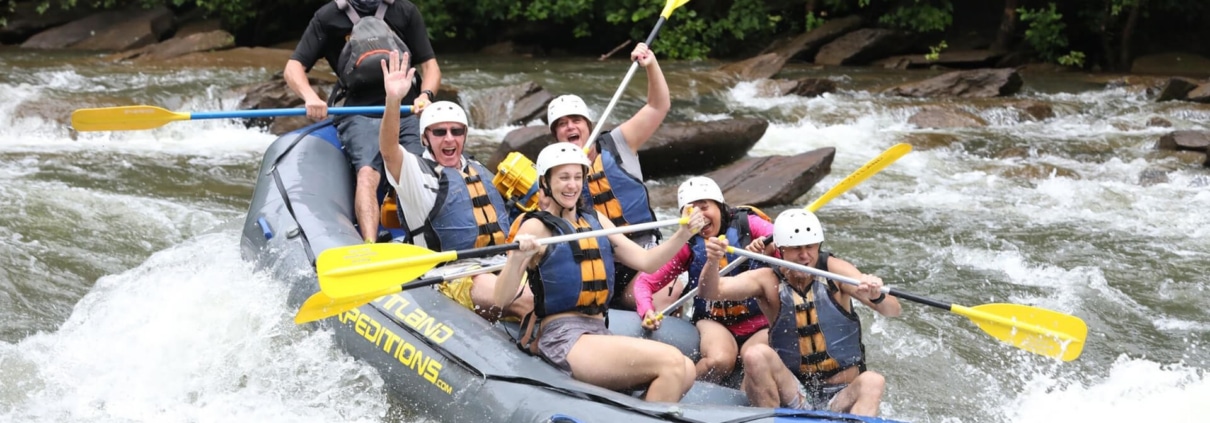Intermediate White Water Rafting Skills: A Comprehensive Guide
White water rafting is an exhilarating adventure that offers thrill-seekers the opportunity to navigate nature’s most exciting waterways. For those who have mastered the basics and are ready to tackle more challenging rapids, advancing to intermediate skills is the next step. This comprehensive river rafting guide will provide you with the essential techniques, tips, and knowledge needed to elevate your white water rafting abilities. With insights from the expert guides at Outland Expeditions, you’ll be well-prepared for your next adventure on the Ocoee River or any other intermediate-level rafting destination.
Understanding Intermediate White Water Rapids
Class III and Class IV Rapids
Intermediate white water rafting typically involves navigating Class III and Class IV rapids. These rapids are more complex and require a higher level of skill and experience than beginner-level rapids. Class III rapids are characterized by moderate, irregular waves that may be difficult to avoid and require precise maneuvering. Class IV rapids are intense, powerful, and predictable, featuring large waves, holes, and significant drops that demand advanced paddling techniques and quick reflexes.
Outland Expeditions specializes in guiding rafters through these challenging waters, ensuring that you have the necessary skills and confidence to tackle intermediate rapids safely. Their experienced guides are trained to handle the complexities of Class III and Class IV rapids, providing you with expert instruction and support throughout your journey. For anyone using a river rafting guide, these classifications are essential knowledge before committing to intermediate waters.
Essential Intermediate Rafting Skills
Advanced Paddling Techniques
As you progress to intermediate white water rafting, mastering advanced paddling techniques is crucial. Effective paddling requires a combination of strength, coordination, and timing. Here are some key techniques to focus on:
Forward Stroke: The forward stroke is the most fundamental paddling technique. For intermediate rafters, it’s important to refine this stroke to maximize power and efficiency. Focus on using your core muscles rather than just your arms, and ensure that your paddle enters the water near your feet and exits near your hips.
Back Stroke: The back stroke is essential for slowing down or stopping the raft. It involves pushing the paddle blade backwards through the water. Practice this stroke to gain better control over your speed and positioning in the rapids.
Draw Stroke: The draw stroke is used to move the raft sideways, allowing for precise positioning. To execute this stroke, reach out with your paddle and pull the water towards the side of the raft. This technique is particularly useful for navigating tight spots and avoiding obstacles.
Pry Stroke: The pry stroke is the opposite of the draw stroke and is used to push the raft away from an obstacle. Place the paddle blade near the side of the raft and push away, using your body weight to generate force. This stroke helps in making quick directional adjustments.
Reading the River
Reading the river is a vital skill for intermediate rafters. Understanding how to interpret the water’s flow, identify potential hazards, and choose the best lines through rapids will significantly enhance your rafting experience. Here are some tips for reading the river:
-
Scout the Rapids: Before entering a challenging rapid, take the time to scout it from the shore if possible. Look for key features such as rocks, holes, and eddies. Identifying these elements will help you plan your route and avoid hazards.
-
Look Ahead: While rafting, always keep your eyes ahead to anticipate upcoming obstacles and changes in the river. This proactive approach allows you to make timely adjustments and maintain control.
-
Understand Hydraulics: Recognize how water interacts with different features in the river. For example, waves form when water flows over submerged rocks, while holes are created by water pouring over ledges. Knowing how these features affect your raft’s movement will help you navigate more effectively.
Every professional river rafting guide emphasizes river reading as the core skill that separates beginners from seasoned rafters.
Advanced Maneuvering Techniques
Punching Through Waves and Holes
One of the most thrilling aspects of intermediate white water rafting is encountering large waves and holes. Successfully navigating these features requires specific techniques:
Punching Waves: To punch through waves, build up momentum by paddling aggressively as you approach. Lean forward and drive the paddle into the wave, keeping your body low to maintain stability. Maintain a strong forward stroke to power through the crest and into the next section of the rapid.
Navigating Holes: Holes can be tricky and intimidating, but with the right approach, you can navigate them safely. Approach the hole with speed and angle your raft slightly to one side. As you enter the hole, lean forward and paddle ha
Eddy Turns and Peel Outs
Eddies are calm areas of water behind obstacles such as rocks or bends in the river. Mastering eddy turns and peel outs is essential for maneuvering in and out of these areas:
Eddy Turn: To perform an eddy turn, paddle towards the eddy with a slight angle and enter the calm water. Once inside the eddy, use a strong back stroke on the upstream side of the raft to pivot and turn the raft downstream. This technique allows you to rest and regroup before continuing down the river.
Peel Out: A peel out is the reverse of an eddy turn and is used to exit an eddy and re-enter the main current. Position the raft at the edge of the eddy with a slight downstream angle. Paddle forward while leaning slightly downstream to break through the eddy line and re-enter the flow of the river.
These maneuvers are hallmarks of every detailed river rafting guide and are essential for advancing your control on Class III and IV waters.
Safety Considerations for Intermediate Rafters
Proper Gear and Equipment
Safety is paramount in white water rafting, especially as you tackle more challenging rapids. Ensuring that you have the proper gear and equipment is essential. Here’s what you need:
- Life Jacket: A high-quality, properly fitted life jacket is non-negotiable. It should provide buoyancy and keep you afloat in case you fall out of the raft.
- Helmet: Wearing a helmet protects your head from potential impacts with rocks and other obstacles.
- Paddle: Choose a paddle that matches your strength and paddling style. A paddle that’s too short or too long can hinder your performance.
- Appropriate Clothing: Wear moisture-wicking, quick-drying clothing that provides insulation and protects against the sun. Neoprene wetsuits or drysuits are ideal for colder conditions.
Self-Rescue Techniques
While rafting with a guide significantly reduces the risk of accidents, knowing self-rescue techniques is crucial for intermediate rafters. Here are some essential skills:
- Swim Aggressively: If you fall out of the raft, swim aggressively towards safety. Use a combination of back strokes and powerful kicks to reach the shore or an eddy.
- Float Position: Assume the float position by lying on your back with your feet pointed downstream and your head upstream. This position allows you to see where you’re going and use your feet to push off obstacles.
- Re-Entering the Raft: Practice re-entering the raft from the water. This technique involves grabbing the side of the raft, kicking your legs, and pulling yourself up with the help of your teammates.
The Role of Outland Expeditions in Your Intermediate Rafting Journey
Expert Guidance and Support
Outland Expeditions is dedicated to providing rafters with the best possible experience on the Ocoee River. Their guides are not only skilled rafters but also experienced instructors who are passionate about sharing their knowledge. By choosing Outland Expeditions for your intermediate rafting adventure, you’ll benefit from their expertise, ensuring a safe and enjoyable journey.
Customized Intermediate Trips
Outland Expeditions offers customized trips tailored to the skill levels and preferences of intermediate rafters. Whether you’re looking for a day trip or an extended adventure, they can design an itinerary that meets your needs. Their trips include thorough safety briefings, advanced instruction, and the opportunity to practice and refine your abilities. For anyone searching for a trusted river rafting guide, their approach delivers both challenge and confidence.
Conclusion
Intermediate white water rafting offers an exciting progression from beginner-level experiences, presenting new challenges and opportunities for skill development. By mastering advanced paddling techniques, learning to read the river, and understanding essential safety considerations, you’ll be well-prepared to tackle Class III and Class IV rapids with confidence. Outland Expeditions is your partner in this journey, providing expert guidance, customized trips, and a commitment to safety that ensures an unforgettable rafting adventure.
Whether you’re looking to enhance your skills, experience the thrill of more challenging rapids, or simply enjoy the natural beauty of the Ocoee River, Outland Expeditions has the expertise and resources to help you achieve your goals. Embark on your intermediate white water rafting adventure with Outland Expeditions and discover the exhilaration and satisfaction that comes with conquering the river’s most exciting challenges.




Leave a Reply
Want to join the discussion?Feel free to contribute!